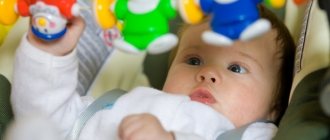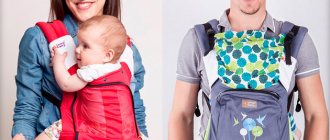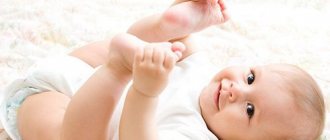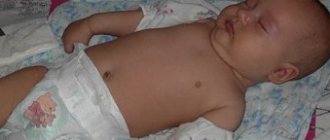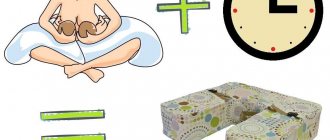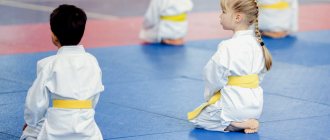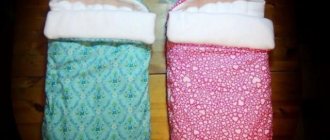You probably need to start with the fact that the opinion of the Ministry of Health and the position of some pediatricians are radically different, therefore everything you read is advisory in nature, and the specified prohibitions and restrictions are only provided that this norm is generally accepted and supported by all parties.
What is a "kangaroo"
Initially, they were conceived and created as a “Hands free” design for mothers who need to go to the store, clean the house, and cook food. Its essence is simple - holding the child under constant visual control in close proximity without hand fatigue.
Speaking about how many months it can be used, it is necessary to clarify that this entirely depends on the specific design of the individual product. One way or another, the carrier bag is a kind of backpack, dressed back to front with the same straps that hold both the structure and the child.
In modern society there are two fundamentally different models:
- Kangaroo for a child's lying position (used for transporting children under 6-7 months of age in a car);
- A sitting bag (in fact, it is more standing), in which the child has free arms and partially legs (the support is on the back and butt, and the chest support is connected by a belt passed between the legs). This design is intended for transporting children older than 6-7 months (that is, those who can already sit independently).
When can you put your baby on his feet>>
When can a child sleep on a pillow, why not rush and what kind of pillow is needed:
Sling backpack vs kangaroo: test drive with pictures
1. Kangaroo is used briefly and infrequently. You can’t carry a heavy and large child in it; they are designed for children up to 74-80 cm tall and weighing up to 8-12 kg. The ergonomic backpack is designed to be worn from birth (or from 3 months) to 16-25 kg. Some children weigh 16 kg already at one year. Moreover, per year, these 74-80 cm and 12 kg may not walk as well with their legs as they would like, but they regularly ask to use their arms. Why is it difficult to wear a kangaroo for more than an hour - see point 7.
2. Kangaroo straps (with rare exceptions) are thin and narrow. The straps of the sling-backpack are wide and dense. A sling backpack almost always has a thick, wide belt. Kangaroos, as a rule, do not have a belt or it is not functional.
3. The position of the child’s legs, no matter how kangaroo manufacturers describe it, can be considered conditionally physiological only for children under two months, and then only on condition that the distance between the child’s legs is at least 20 cm, and for most kangaroos this distance is less. In the future, the legs will hang down, interfere with the parent when walking and cause anxiety to the child (that’s why they usually don’t carry more than 9 kg, it’s uncomfortable for the child, and uncomfortable and difficult for the parent). The position of the legs in an ergonomic backpack is physiological, i.e. corresponds to natural needs: a human child is born immature, and his hip joints are often immature. The position with the legs apart serves as a means of preventing hip dysplasia (this disease can be hidden and worsen throughout the first year of a child’s life), and is also as comfortable as possible for the child and the parent, both when worn in a backpack, and simply when worn on the hands.
And this photo is especially for BabyBjorn Active kangaroo supporters. The position of the child's legs is absolutely the same as in a regular kangaroo, although the manufacturer positions it as physiological.
4. A hard back is NOT NEEDED. It’s one thing when a child lies on a hard surface. Although even in the crib, the child often does not lie on his back, but tries to curl up in a ball, as in the womb. And it’s completely different when they try to carry it vertically in a hard case. To carry a child vertically, you need a soft back with the ability to adjust the tension of the fabric for optimal back support. An indicator of good attraction is the ability for the mother to bend over: in a kangaroo baby, even with the straps tightened as much as possible, the baby dangles and sag; in a sling-backpack, it is pulled tightly and repeats the mother’s movement, nothing more.
6. Breastfeeding in a kangaroo is almost impossible or very difficult, because A belt system runs between mother and child. In a sling-backpack, the baby is pulled directly to the mother, nothing interferes with feeding, it is enough just to loosen the straps a little during feeding and lower the baby a little lower.
7. All the design features of the kangaroo: thin straps, the absence of waist support or its ineffective imitation, hanging the child in a case from belts worn by the mother, the position of the child’s legs - lead to the fact that the mother’s center of gravity is shifted, she has to strain her lower back to hold balance, and the shoulder girdle bears almost the entire weight of the child, i.e. the straps cut in and press. In an ergonomic backpack, the center of gravity is practically not shifted, the child’s weight is evenly distributed between the mother’s shoulders, back and hips. Result: the mother’s back practically does not get tired even after carrying the baby in a backpack for a long time.

A variety of baby carriers are very popular. They are comfortable, take up little space compared to a stroller and leave the mother's hands free. One of the first such devices to appear was the kangaroo backpack. Before using it, parents need to know from how many months and for how long they can carry a child using this design.
When not to use
"Kenguryatnik" is contraindicated for children:
- with diseases of the musculoskeletal system,
- with mental or neurotic disorders.
In certain circumstances, it is undesirable to use a bag for broken limbs, as well as for overweight or severe underweight.
All restrictions on the orthopedic profile are related to the physiology of the child’s body and the incompletely developed (not fully formed) skeleton.
kangaroo for newborns from how many months
KANGAROO SLING
is a hybrid between a kangaroo and a sling. It is designed for children from four to six months to three years of age. A unique thing - visually it looks like a kangaroo backpack, but at the same time it is physiological and safe, like a sling.
Also read: It’s painful to walk after childbirth
Kangaroo sling “Classic”
is a child-wearing device that can be used
from 4 months to 3 years
.
The product has a foam pad in the back area that supports the baby's head. The side parts of the product are not lined with foam rubber, which allows the child’s body to breathe. The product has soft pads in the area of the baby's popliteal cavities to alleviate pressure.
IN A KANGAROO SLING
the lower part of the device is expanded. The fabric supports the baby from knee to knee, while the baby's legs are spread apart, and the load on the perineum and spine is minimal. In addition, orthopedists recommend carrying the baby with his legs wide apart around the mother's waist. This position promotes the proper development of the hip bones and is the prevention of a number of diseases associated with the spine.
Design requirements or how to choose the right one
The simplicity of the “kangaroo” presupposes compliance with several basic rules and requirements, on which the safety of the child and the health of the mother depend.
- Softness and strength of fastening (applies equally to belts and elements for fixing their required position). Here you should understand the quality of the belt support as a whole:
- the material from which these parts of the structure are made (soft, non-irritating, not a source of a possible allergic reaction and comfortable for the mother’s back - selected individually according to the characteristics of the body constitution);
- additional elements (rivets, zippers, buckles, buttons) must be made of hypoallergenic materials and not have sharp edges or corners to prevent injury;
- firmware, lining (for softness) and the quality of the seams with which the belts are connected to the main supporting “cradle”.
- The material and rigidity of the supporting frame (it is, as a rule, fabric, possibly two-layer with a soft interlining made of artificial filler, batting, padding polyester). Stiffness refers to the tension of the fabric and its ability to stretch under the influence of the child’s weight.
- The number of elements holding the baby and the presence of several operating positions for the product.
In general, if you look more closely and carefully, there are signs by which you can distinguish a good, worthwhile item from consumer goods sewn in the basement, for example: changes in color, size and density after washing, stretching of belts and fastenings during long-term use.
All children's products must have the necessary documents confirming the certification, and a copy of the product quality guarantee certificate must also be available.
Especially for hurrying and fussing mothers, we remind you that children's carrier bags are sold (if they are branded and of high quality) in individual packaging, where along with the product there must be paper with the name of the manufacturer, place of production and the seal of the quality control department (if the model is dismountable, then assembly diagrams and a verified list of completeness of the supplied product must be attached.
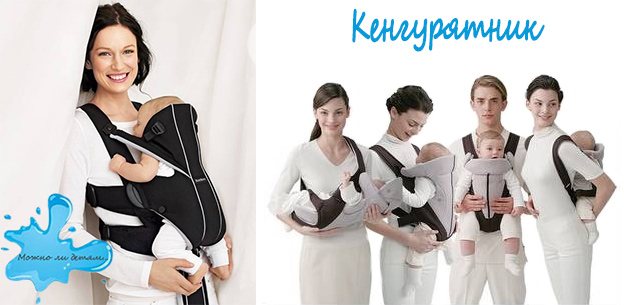
How to choose a carrier
To make the carrier as safe and comfortable as possible for mother and baby, you need to choose a high-quality and modern model. To do this, you need to pay attention to important aspects:
When choosing a kangaroo, you need to be guided by the clarity and simplicity of the design. Extra details will not bring any benefit, but will only make it more difficult to use.
According to reviews from mothers, the most popular brands of kangaroos are Chicco, Inglesina, Geoby, BabyBjorn, Womar. The use of high-quality materials and anatomically correct parameters of these products ensure comfort for adults and children.
World experience and domestic developments
According to European and North American statistics, about 70% of mothers have used a kangaroo at least once, while only 43% of them continued to use the product. This suggests that in most cases mothers prefer to carry the child in their arms, since control over the position of the child’s body is more complete.
If we compare baby carriers before and after 6-7 months, preference is given to recumbent options because of their functionality. And at a later date, strollers and boxes that are inserted into them are more often used.
Recently, more and more often, young mothers give preference to the eastern versions of “kangaroos” - it’s quite difficult to call them full-fledged bags, but the child sits in them quite confidently, and only the mother’s neck and shoulders get tired. The design, developed in Japan, is a frameless fabric (wool for cold weather, bamboo for hot weather) sling across the neck and under one arm (optional). It is interesting that in this design there is only one component and one single fastening - a wide strip of fabric, cut at an angle and a standard buckle with two or three jumpers for more precise fixation of the required position.
Domestic pediatrics, represented by leading doctors and research specialists, is inclined to the opinion that the use of “kangaroos” at a very early age is undesirable, but after the child begins to sit confidently (individually, usually after 6-8 months) - as much as necessary (without fanaticism, of course).
Separately, it is worth noting domestic developments, which provide not only for carrying a child, but also for feeding without unfastening or removing the device from the shoulders.
Oddly enough, only in domestic models there is an additional supporting “section” for the abdomen and chest (for comparison, in foreign models they are usually limited to belts).
At what months can a baby be placed in a kangaroo?
The baby is growing, becoming more active and inquisitive. The rhythm of life changes for both mom and dad. Parents are increasingly interested in the issue of active walks in the fresh air. For such cases, manufacturers of children's goods have come up with baby carriers. Every parent has thought about the age at which a child can be placed in a kangaroo, and whether this type of “transport” is harmful for the baby.
More to read: Ultrasound 34 weeks of pregnancy indicators
Types of kangaroo backpacks for children
There are several types of kangaroo backpacks:
- Transformable carriers.
These are new types of kangaroo backpacks that allow you to carry a child in different positions: sitting and lying down. This type is intended for walks with the baby from birth. This will allow mom or dad to constantly be in contact with their baby, because in the first months of life this is especially important. - Single position carriers.
These are backpacks in which children sit while sitting. The instructions for these carriers indicate at what age a child can be placed in a kangaroo - from 4 months.
Please note that if for some reason at 4 months your baby cannot hold his head up or is in poor health, consult your pediatrician about when you can put your baby in a kangaroo and how long he can stay in the backpack. Doctors are of the opinion that at 4 months the baby can already be placed in a carrier. However, a more optimal age is closer to 6 months. After all, at this age, babies begin to sit independently.
Now, I would like to say a few words about the time a child spends in a backpack. You need to start wearing your baby for 10-15 minutes a day. This is necessary so that the baby gets used to the new type of “transport” and his legs do not become numb. Over time, continuously wearing a child can increase to two hours or more.
To summarize, we can say that the time at which months a child can be placed in a kangaroo is the period from 4 months to six months. This is the most optimal age for introducing your baby to a baby carrier in a sitting position. If you have a transformable kangaroo, then from birth. Carrying babies in a carrier is not harmful if you maintain the time limits for the child to be in the backpack and the baby is comfortable in the kangaroo.
Now, I would like to say a few words about the time a child spends in a backpack. You need to start wearing your baby for 10-15 minutes a day. This is necessary so that the baby gets used to the new type of “transport” and his legs do not become numb. Over time, continuously wearing a child can increase to two hours or more.


